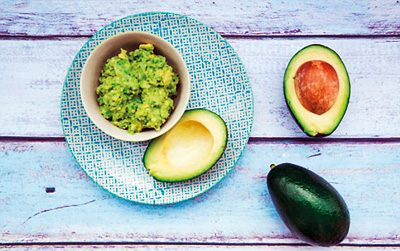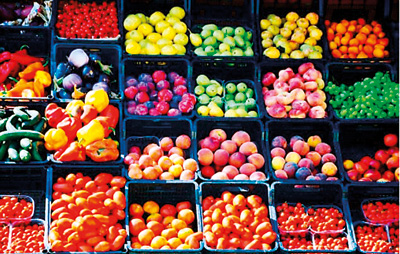Always hungry? Here’s why
View(s):Always hungry? Foraging the fridge and kitchen cupboards often?
Why do you feel hungry, even soon after you’ve cleared your meal away, and why does this pattern keep repeating itself?
The resulting ‘grab and run’ approach to eating has become a way of life and we’re convinced that this is the only way to get through the day.

Fat increases satiety by working on the brain pathways that reduce the reward associated with food. Avocado is a good source of monounsaturated fat, and helps reduce hunger pangs
These hunger pangs don’t disappear until you stop what you’re doing and address your body’s need.
Temporarily satiated with the easiest snack or meal you can find, your body releases you to continue with the tasks ahead.
Your body is in charge but, by understanding and addressing the reasons why it’s calling these shots, you can regain control.
We all have hunger hormones that guide this roller-coaster; their role is to make us either feel hungry or full up.
Leptin, made by fat cells, decreases your appetite.
Ghrelin, on the other hand, is made in the stomach and increases appetite.
Ghrelin is high before you eat, signalling the brain that you are hungry and low once you’ve eaten.
This response is more pronounced if you are overweight as leptin signals the brain that you have enough fat, so you can eat less or stop eating.
In general, the more fat you have, the more leptin you make and therefore the less food you are inclined to eat.
Conversely, thinner people have less leptin and will therefore be hungrier, as the brain does not receive the message to eat less or stop eating.
However, studies show that in overweight and obese people, this mechanism has broken down and there is a resistance to the appetite suppressing effects of leptin, known as leptin resistance.
In other words, your appetite is not suppressed easily and you are hungry more often than not.
The vicious cycle perpetuates itself as you then eat more, put on more weight, become hungrier and so on.
So let’s see how we can control these hormones, particularly the ghrelin, by looking at some of the reasons why you’re always hungry:
1. You’re carb loading
The notion of filling up on rice, pasta and bread has long been held as a strategy to ensure you are replete and you stay full after a meal.
However, refined carbohydrates like white rice, white pasta and white bread, as the name suggests, have been through a manufacturing process that has removed the outer husks of the grains, leaving just the inner sugar part.
Once these refined grains reach your stomach, there is very little left for the digestive process to do and the sugar is quickly released into the blood stream.
 The hormone insulin removes these blood sugars and this sugar surge is quickly followed by a sharp dip in blood sugars, triggering a sugar craving and the hunger pangs will kick in soon after.
The hormone insulin removes these blood sugars and this sugar surge is quickly followed by a sharp dip in blood sugars, triggering a sugar craving and the hunger pangs will kick in soon after.
So, it is not only important to replace these quick releasing white versions with more complex, wholegrain options, such as brown rice, brown pasta and wholemeal bread, but also with vegetables, such as butternut squash or sweet potato, which are more slow releasing carbohydrates, keeping you fuller for longer.
2. You’re not including protein
in every meal or snack
Protein is a complex nutrient and takes longer to break down during the digestive process.
It therefore remains in your stomach for longer, so keeping you full.
Include good quality lean protein with each meal and snack. For example, add sliced turkey, eggs, tuna or beans or pulses to a large salad or snack on edamame beans or nut butter on celery sticks.
Greek (not Greek-style) yoghurt has a higher protein content due to traditional Greek straining methods and is an ideal breakfast with berries and a sprinkle of protein-rich nuts/seeds.
3. You’re not eating enough fat
Studies show that fat increases satiety by working on the brain pathways that reduce the reward associated with food.
As with protein, fats are also a complex nutrient, that requires longer to break down and therefore remains in your stomach for longer.
Avocado provides good levels of monounsaturated fats that satiate; add to a salad, slice alongside scrambled egg or simply mash on sourdough toast with a drizzle of olive oil, for a delicious breakfast that will keep you going and reduce your hunger pangs.
4. Fibre doesn’t feature
Fibre bulks and binds and is essential for a healthy digestive system.
There are two types of fibre; Insoluble fibre, which adds bulk to your stool and ensures healthy elimination and soluble fibre, which dissolves into a gel-like consistency and contributes to how full we feel.
Vegetables provide plenty of fibre, ideally half your plate should be made up of vegetables.
The fibre and water content of vegetables help you to stay fuller for longer.
So, always think in terms of ‘how many’ portions of vegetables you can include with your meal and varying the colours will make your meal more interesting and appealing.
For example, try broccoli or green beans with red cabbage or roasted tomatoes and asparagus with your usual leaves and salad vegetables.
According to the recently revised BANT Wellbeing Guidelines, you’re aiming for 7-a-day.
Also consider a small handful of nuts and an apple as a snack.
The high-fibre content slows down how quickly they are digested and also buffers the sugar content of the apple.
The apple skin contains pectin, which controls blood sugar spikes that lead to hunger pangs.
Beans are also high in fibre and can be added to a soup or sprinkled on salads or eaten as a snack such as hummus or garlic parmesan chickpeas.
5. You’re eating too much fruit
Although fruit contains the natural sugar, fructose, it is still a sugar and consumption should be limited to a maximum of two portions per day.
It is often easy to use fruit as a sugar crutch, with its sugar content providing the boost you need if you’re due a meal or have skipped a meal all together.
A longer lasting snack, combining protein and fibre will satiate and keep you fuller for longer.
6. You think you’re hungry
Since we rely on many foods to provide water, when you are dehydrated your body can send out hunger signals, thereby increasing your appetite.
These deceiving hunger pangs cause you to mistake thirst for hunger, so if you’re feeling hungry, try drinking a glass of water in the first instance and see if you are satisfied.
Ensure you remain hydrated by drinking in between meals.
Herbal teas or fresh mint can act as an appetite suppressant but coffee will encourage cravings; its stimulatory effects will result in cortisol release, consequently leading to sugar surges and dips.
Eating plenty of vegetables and fruit (max two per day) that are high in water such as oranges, apples or cucumber will also maintain your hydration levels.
7. You’re eating too quickly
Despite our busy lives, it is important to take the time to savour and enjoy your meal.
Chewing your food more thoroughly gives your body time to register that you have eaten and are no longer hungry.
Certain foods such as almonds, avocado and oats promote the appetite-regulating intestinal hormone Cholecystokinin (CCK), released as part of the digestion process, which signals the brain that you are full.
It can take 15-20 minutes after your food is eaten for these messages to reach the brain and signal a feeling of fullness.
8. You’re not eating enough
You’ve embarked on a new healthy eating regime and are limiting your food intake at each meal or even skipping meals all together.
Although your enthusiasm and willpower may get you through the first few days, it is unlikely that you will be able to sustain this and your hunger pangs will inevitably get the better of you.
If you’re looking to limit your calorie intake, but don’t want to spend the day hungry, why not start a meal with a vegetable or broth based soup or a salad starter.
By increasing your meal size with these healthy starters, you’re not only more likely to feel full for longer, but you’ll be boosting your nutrient intake as well as promoting more efficient digestion, as your stomach releases digestive enzymes, so that they are already present when the main meal eventually arrives.
9. You’re sleep deprived
Studies show that the less sleep you have, the more you eat.
The lack of sleep interferes with the leptin and ghrelin response mechanism; increasing the hunger hormone ghrelin and reducing appetite-suppressing leptin.
In addition, you are likely to eat more to compensate for the fatigue and lethargy the following day.
Consider your sleep hygiene, focusing on relaxing at the end of the day with a warm bath, a herbal tea and switching off gadgets, such as mobile phone, tablets and computers.
A diet high in stimulating sugary foods during the day also contributes to sleep quality and can lead to disrupted sleep.
10. You’re obsessed!
Are you obsessed about your food choices, constantly checking the internet for recipe and meal ideas, flicking though magazines, watching endless cooking shows/competitions or discussing diet trends with colleagues and friends.
This constant focus keeps food at the forefront of your mind and unsurprisingly, you are more likely to convince yourself you are hungry and therefore less likely to resist temptation.
Distract yourself by getting stuck into a project or piece of work, go out for a walk or pick up a book in between meals. (This article first appeared in Healthista and was republished in the Daily Mail, London)


